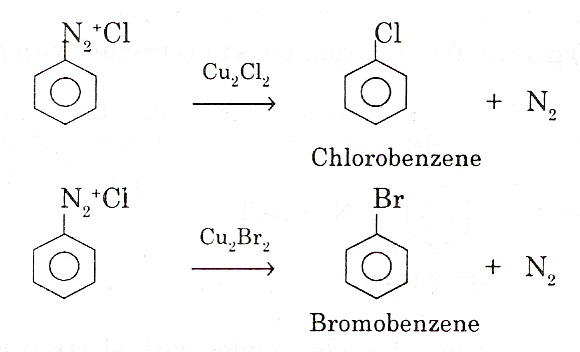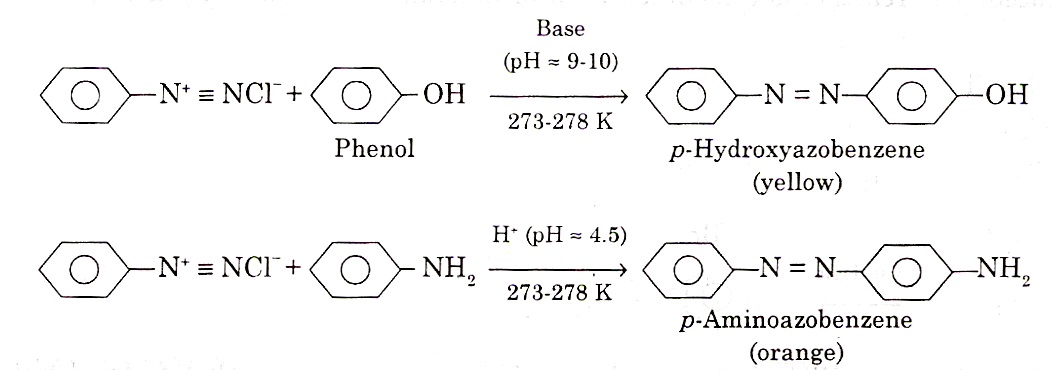The dizaonium salts have the general formula ArN2+X–, where X – may be an anoin like Cl–, Br– etc. and the group N2+ (─N≡N+) is called diazonium ion group. These are obtained when aromatic primary amines react with nitrous acid.
Preparation of Diazonium salts: Benzene diazonium salts can be prepared by heating an ice cold solution of primary amines in excess of mineral acid like Hcl or H2SO4 with an ice cold solution of sodium nitrite dissolved in water. The temperature of the reaction is maintained between 0-5ºc because most of the diazonium salts decompose at higher temperature.
NaNO2 + Hcl ———> Nacl + HONO
Ar—NH2 —(NaNO2/Hcl—-> Ar—N≡N+ Cl + NaCl + H2O
Aromatic amine Diazonium chloride
For example, benzene diazonium chloride is prepared by treating an ice cold solution of aniline in hydrochloric acid with an ice-cold solution of sodium nitrite at about 0ºc. The reaction of converting aromatic primary amine to diazonium salt is called Diazotisation.
 Physical Properties of Diazonium Salts: The general physical properties of diazonium salts are-
Physical Properties of Diazonium Salts: The general physical properties of diazonium salts are-
- Diazonium salts are generally colourless, crystalline solids.
- These are readily soluble in water but less soluble in alcohol.
- They are unstable and explode in dry state. Therefore, they are generally used in solution state.
- Their aqueous solutions are neutral to litmus and conduct electricity due to the presence of ions.
Chemical properties of Diazonium Salts: The diazonium salts give the follwing types of reaction-
Substitution reactions: In substitution or replacement reactions, nitrogen of diazonium salts is lost as N2 and different groups are introduced in its place. Some of the important replacement reactions are –
1) Reaction with water: When an aqueous solution of diazonium chloride is boiled with water, it gives phenols.
 2) Reaction with hypophosphorus acid: When diazonium chloride is treated with hypophosphorus acid, benzene is formed.
2) Reaction with hypophosphorus acid: When diazonium chloride is treated with hypophosphorus acid, benzene is formed.
 3) Reaction with cuprous chloride or cuprous bromide: When diazonium chloride solution is warmed with cuprous chloride or cuprous bromide the corresponding halide is formed.This reaction is called Sandmeyer reaction.
3) Reaction with cuprous chloride or cuprous bromide: When diazonium chloride solution is warmed with cuprous chloride or cuprous bromide the corresponding halide is formed.This reaction is called Sandmeyer reaction. When the diazonium chloride is warmed with copper powder and the corresponding halogen acid, the respective halogen is introduced. The reaction is a modified form of Sandmeyer reaction and is known as Gattermann reaction.
When the diazonium chloride is warmed with copper powder and the corresponding halogen acid, the respective halogen is introduced. The reaction is a modified form of Sandmeyer reaction and is known as Gattermann reaction.
 4) Reaction with KI: When aqueous solution of diazonium chloride is warmed with excess of potassium iodide, aryl iodide is formed.
4) Reaction with KI: When aqueous solution of diazonium chloride is warmed with excess of potassium iodide, aryl iodide is formed. 5) Reaction with fluoroboric acid: When diazonium chloride is treated with fluoroboric acid (HBF4), the flurorobenzene is formed. This reaction is called Schiemann reaction.
5) Reaction with fluoroboric acid: When diazonium chloride is treated with fluoroboric acid (HBF4), the flurorobenzene is formed. This reaction is called Schiemann reaction.
 6) Reaction with copper cyanide: When diazonium chloride is treated with copper cyanide, cyanobenzene is formed.
6) Reaction with copper cyanide: When diazonium chloride is treated with copper cyanide, cyanobenzene is formed.
 7) Replacement by Nitro group: Nitrobenzene is prepared by decomposing diazonium fluoroborate with aqueous NaNO2 in the presence of copper powder.
7) Replacement by Nitro group: Nitrobenzene is prepared by decomposing diazonium fluoroborate with aqueous NaNO2 in the presence of copper powder.
 8) Reaction with potassium hydrosulphide: When diazonium chloride is treated with potassium hydrosulphide, thiophenol is produced.
8) Reaction with potassium hydrosulphide: When diazonium chloride is treated with potassium hydrosulphide, thiophenol is produced.
 9) Coupling reaction: Benzene dioazonium chloride couples with electron rich aromatic compounds like phenols and aniline to give azo compounds. The azo compounds contain –N=N- bond and the reaction is called coupling reaction.
9) Coupling reaction: Benzene dioazonium chloride couples with electron rich aromatic compounds like phenols and aniline to give azo compounds. The azo compounds contain –N=N- bond and the reaction is called coupling reaction.
 Uses of diazonium salts: Diazonium salts are used-
Uses of diazonium salts: Diazonium salts are used-
- For the manufacture of azo dyes.
- For the industrial preparation of important organic compounds like m-bromobenzene, m-bromophenol, etc.
- For the preparation of a variety of useful halogen substituted arenas.